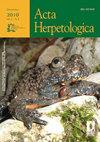宽嘴凯门鳄(鳄科:短吻鳄科)的骨组织学作为鳄鱼形态生理推断的工具
IF 0.9
4区 生物学
Q4 ZOOLOGY
引用次数: 2
摘要
骨组织学是解释过去和现存动物群生活模式的重要工具。番红花已经被研究为形态生理特征的重要推断模型。我们的目的是对圈养Caiman latirostros的骨组织学进行表征,确定其与生长速率、个体发育和环境条件相关的微观解剖。我们分析了雌性凯门鳄的五对肱骨(阑尾骨骼的近端元素)和肋骨(轴向骨骼)。肋骨通常显示编织纤维组织,具有低血管化和平行纤维骨,以及许多吸收和侵蚀腔。它显示了三个个体的生长停滞线(LAGs),没有骨骼时间兼容性。随着个体的衰老,Humeri表现出编织纤维到平行纤维和板层带状骨的梯度。我们在较老的标本中观察到致密的粗松质骨(CCCB)和较高数量的LAG。肋骨的重塑速度快于肱骨,显示出个体内的组织变异性。肱骨具有明显的生长模式,不同个体发育阶段和不同年龄段的生长速率不同。快速生长的组织在鳄鱼中并不常见,但基础代谢和最佳生长条件可能会导致这种情况。latirostris的骨组织学显示出可以作为现存和灭绝群体的推断模型的模式,但我们鼓励在不同的环境条件下进行进一步的研究,以更好地理解,如温度和食物可获得性。本文章由计算机程序翻译,如有差异,请以英文原文为准。
Bone histology of Broad-snouted Caiman Caiman latirostris (Crocodylia: Alligatoridae) as tool for morphophysiological inferences in Crocodylia
Bone histology is an important tool for the interpretation of life patterns in animals of the past and extant fauna. The crocodylians have been studied as important inferential models for morphophysiological characteristics. We aimed to characterize the osteohistology of captive Caiman latirostris, identifying its microanatomy related to growth rates, ontogeny, and environmental conditions. We analyzed five pairs of humeri (proximal elements of the appendicular skeleton) and ribs (axial skeleton) of females’ caiman. Ribs showed, in general, woven-fibered tissues, with low vascularization and parallel-fibered bone and many resorption and erosion cavities. It presented lines of arrested growth (LAGs) in three individuals, without skeletochronological compatibility. Humeri showed a gradient of woven-fibered to parallel-fibered and lamellar-zonal bone as the individuals aging. We observed compacted coarse cancellous bone (CCCB) and a higher number of LAGs in older specimens. Ribs remodel faster than humerus, showing an intra-individual histovariability. The humeri indicated an evident growth pattern with different ontogeny stages and growth rates in different ages. Fast-growing tissues are uncommon in crocodylians, but basal metabolism and optimal growth conditions can lead to this. Bone histology of C. latirostris shows patterns that can be used as inferential models for extant and extinct groups, but we encourage further studies for a better understanding, under different environmental conditions, such as temperature and food availability.
求助全文
通过发布文献求助,成功后即可免费获取论文全文。
去求助
来源期刊

Acta Herpetologica
ZOOLOGY-
CiteScore
1.20
自引率
12.50%
发文量
10
审稿时长
6 months
期刊介绍:
Acta Herpetologica, a journal open to academics all over the world, offers itself as a new site for the presentation and discussion of the most recent results in the field of research on Amphibians and Reptiles, both living and extinct. The official journal of the Societas Herpetologica Italica (S.H.I.), Acta Herpetologica publishes original works – extended articles, short notes and book reviews – mostly in English, dealing with the biology and diversity of Amphibians and Reptiles.
 求助内容:
求助内容: 应助结果提醒方式:
应助结果提醒方式:


